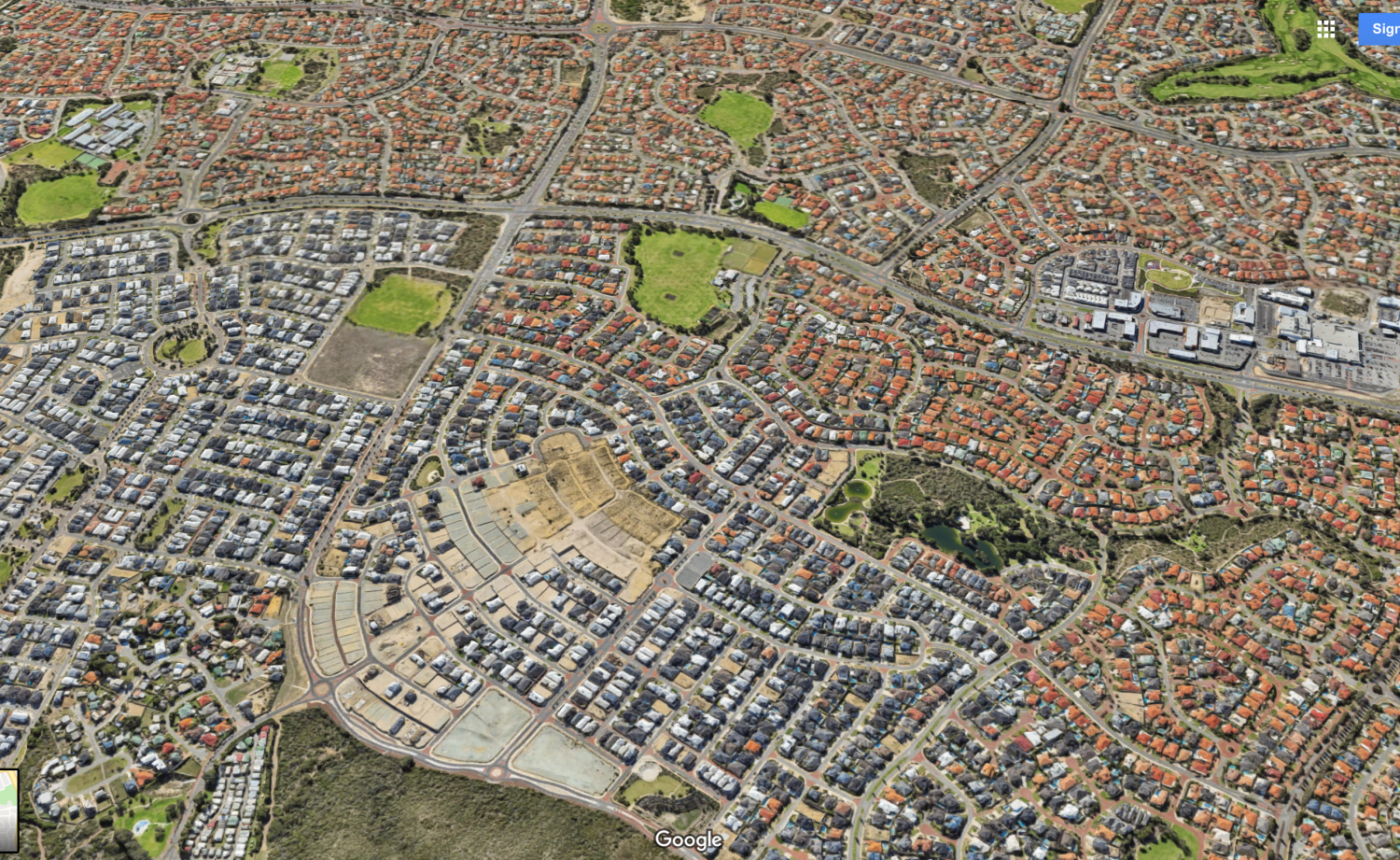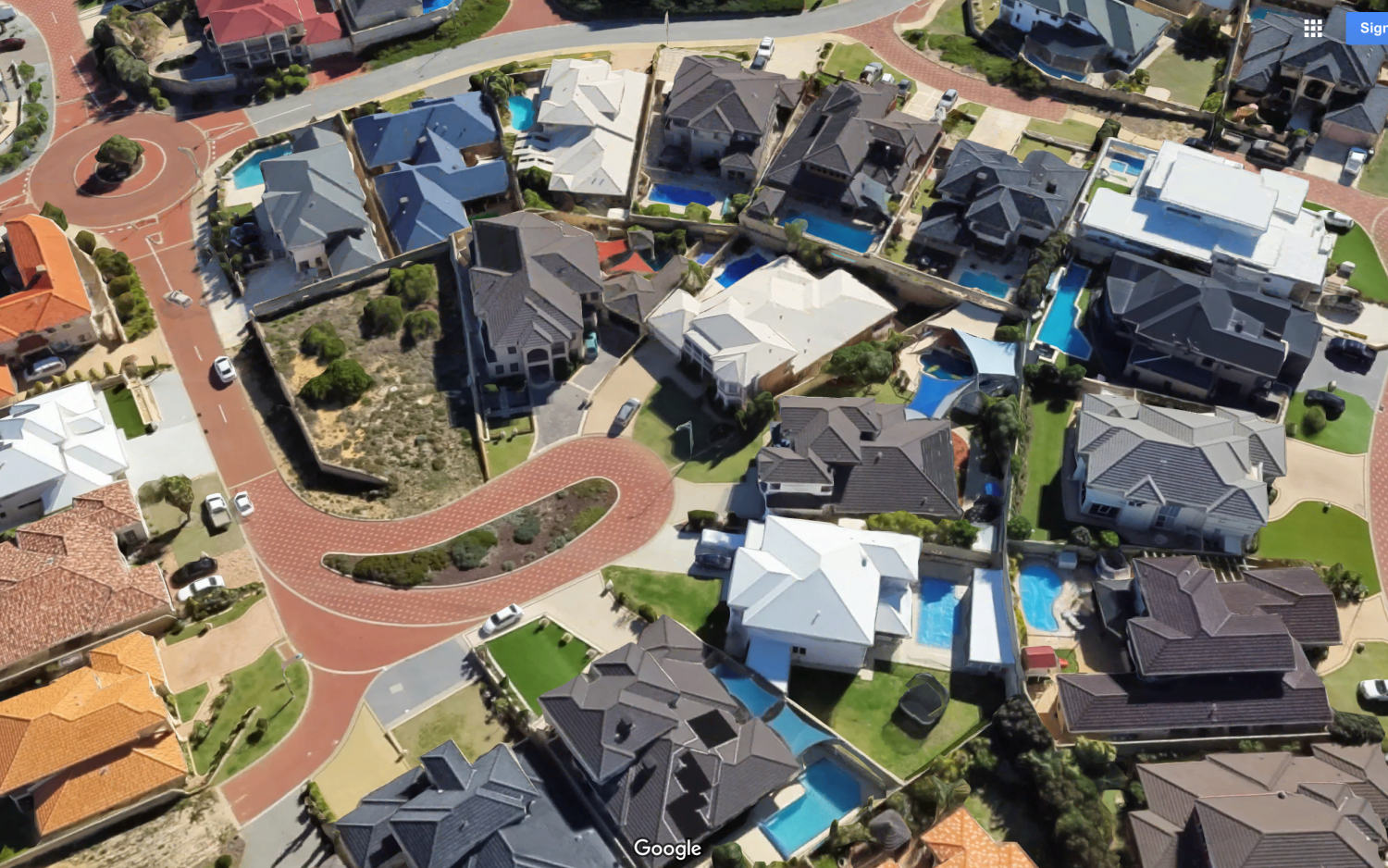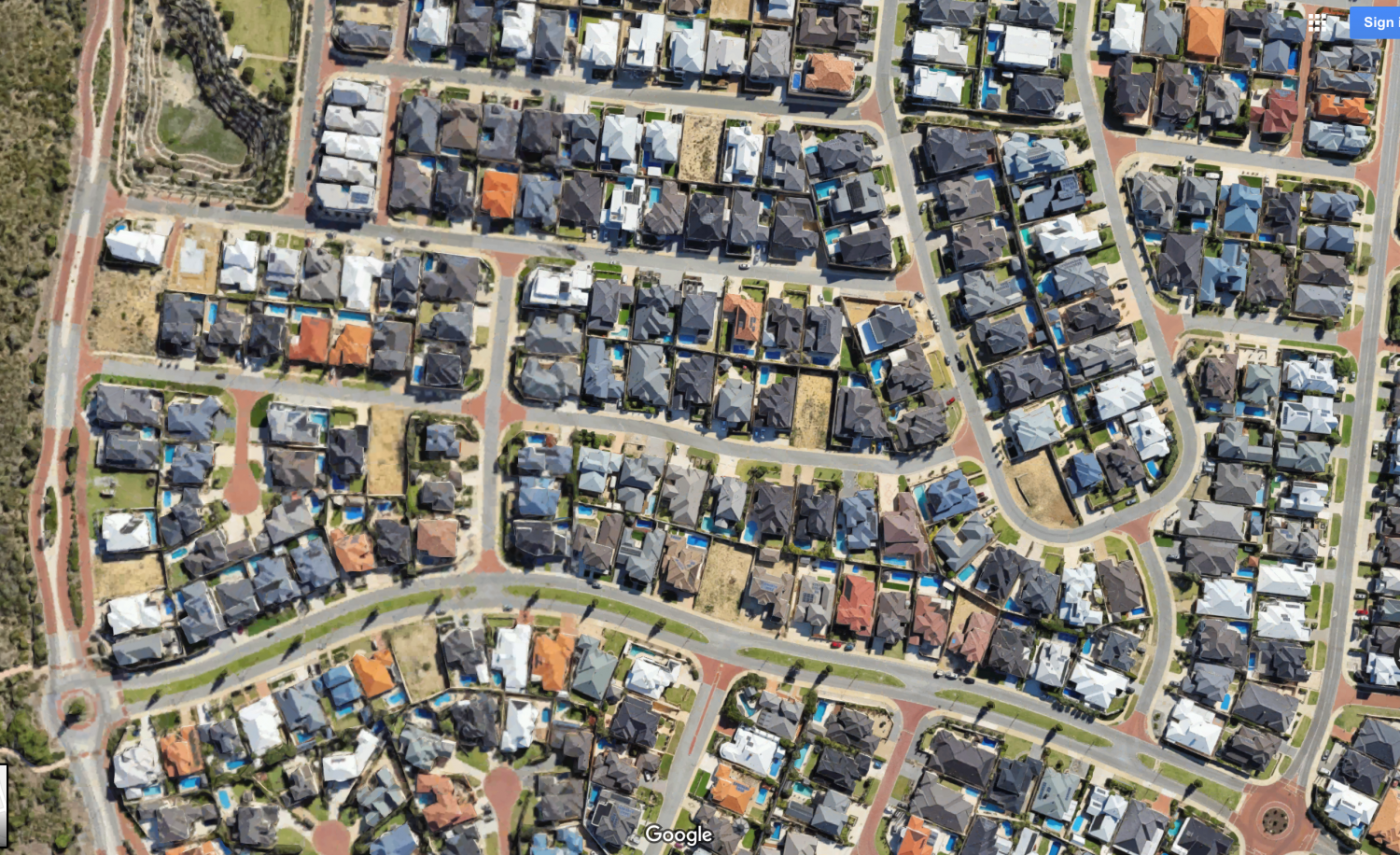Do you know where the longest urban sprawl in the world is? It’s a little city with just under two million people in the middle of nowhere. Literally. It’s the most isolated city in the world. It’s Perth in Australia which boasts a newly unofficial title of longest suburban sprawl in the world. Already over 150 kilometres (93 miles) and growing, this is no mean feat. Its new lead over Sochi in Russia has required dedicated urban development to stretch both directions along its coast. It is a design disaster and a failure of modern development.
Perth is filled with flattened lands and huge houses. Originally these were on big blocks too. Nowadays, families have done away with the garden to home pools or bigger houses near their boundaries instead. In 1950, Australia had an average house size of 100 sqm (1,076sqf). It now has an average home size of approximately 240sqm (2,583sqf) to top the list of the biggest homes in the world (competing on-and-off with America). To make matters worse, during the same period, the average number of people per household has declined so the floorspace available to each person has actually tripled. Australia, a resources nation still booming, found its riches, and in it discovered a new housing dream.
It turns out that wealth fuels space.
Suburbia is a multitude of uniform, unidentifiable houses, lined up inflexibly, at uniform distances, on uniform roads, in a treeless communal waste, inhabited by people of the same class, the same income, the same age group, witnessing the same television performances, eating the same tasteless prefabricated foods, from the same freezers, conforming in every outward and inward respect to a common mould.
Environmentally this is a nightmare. To achieve this scale of urban sprawl for mostly all detached homes, Perth has been busy clearing millions of acres of bushland and greenery to make way for template homes and McMansions. In Australia, these houses are built as quick as possible and cheaply (not cheap for the buyers, but cheap in design & execution). Many of these homes in the sprawl come from developers selling houses off-the-plan in a land + house package. Often from a display village. A poor template they repeat over and over again. They’re not homes made to last hundreds and hundreds of years. Look around your neighborhood; what will still be here? Four in five homes in Australia are still built only to the minimum required environmental standards. The homes demand constant maintenance and upkeep. The infrastructure and materials are often inferior. Corners are a mess. Endless roof pitches give the tell-tale sign of inept design. Unlike many European countries where double glazed windows are standard, Australian homes aren’t built for efficient heating and cooling. There were no new rules demanding solar panel systems be built on each new home despite this being an easy possibility due to the highly controlled nature (and wealth) of the market. It’s difficult to imagine what happens in one hundred, or even in fifty, years. The poor quality, in both homes and apartments, will be sitting heavily on the shoulders of the kids of today. In other suburbs, houses not even forty years old are already been torn down to build new ones at a hefty price; fiscally and environmentally. A constant, never ending cycle of using our Earth for resources and then throwing those resources away.
Developers, the companies that rule Australia’s modern suburbs, sell the classic dream to “build your own home” and customers feel like they’ve had input by changing a wall or decorating their rooms. A newly wealthy generation was sold on the idea of ‘theatre rooms’ being a necessary luxury to show off to guests. Those same rooms stand empty most of the year but consume resources to heat them, cool them, clean them and furnish them. Many of these houses were built outside of good public transport networks too making Perth one of the global cities most dependent on cars. In fact most train locations across suburbia require people to drive there first. Many people travel an hour or two each day just to get to work in the city & back. They sit, singularly, in huge cars clogging up the motorway. They spend the entire day at the their job and then get home in the evening to a brick and cement street with only a few trees scattered individually nearby (and usually one lonely pond with a water feature) for aesthetics. That’s the beach lifestyle dream now on offer.

Suburbia like this, across America & Australia, segregates people. It zones them and groups them by likeness. It encourages inequality. It discourages healthy lifestyles with streets designed for cars and mall-style shopping centres the epicentre of the “community”, full of processed food, monopoly chains and fast fashion. What they sell in those designated shopping zones will mostly be thrown into landfill in the next year, low on ethics and marketed to be bought constantly without thought. In fact, head out to the few bush spaces left in the sprawl and you’ll stumble upon a whole selection of household items simply thrown into nature to decay there forever.
There is no art, design or consideration of lifestyle. No deep thought to how one moves and lives beyond the home. Consumption becomes the fuel for life.
Sprawled spaces aren’t equipped for easy, friendly use and they don’t attract cohorts of joggers, dog walkers or cycling couples to a local grocer. There are no enjoyable fresh food cafes and markets with local produce close by enough to regularly ride to. People don’t cycle between their homes to friends and family even where it has been entirely flattened. There is no culture and heritage. No spaces to grow the arts, regularly interact with your neighbors and create a sharing economy within the community. No food gardens and roads planted with fruit trees. They have lost nearly all the shared services that make places liveable & enjoyable and foster responsibility, belonging and pride. Common areas and leisure activities are built in as an afterthought, if they’re provided at all. Life is barely present most hours outside of school. Those same schools are lined with hundreds of SUVs (4WDs in Australia) twice a day with usually one single driver; a mum picking up their child. The cars are never filled, they’re a status symbol or a wish of a different life where surfing and camping occur far more often. After school the suburbs turn quiet outside the hum of transport. Invisible families going about invisible activities behind their cement walls. In turn, safety precautions are added as a necessary solution rather than creating inviting, friendly neighborhoods that encourage people to live beyond their four walls and bring people together.
I have travelled the world and lived in numerous cities. With that benefit, I can confidently say Illuka in the suburban sprawl of Perth is quite possibly my most disliked suburb (thus far, I accept). This isn’t a suburb for the ultra-wealthy (though one could argue of course that at these prices everyone is the wealthy here). It’s tucked between other standard suburban fare. Architecturally it’s a mess like the others. But more than that, it’s the show of wealth and consumption that really gets to me. Illuka is built on the coast. It is quite literally a two minute walk to the beach. And yet nearly each house forewent a productive garden for a pool; an extreme waste of resources. Having neighborhood access to a public run pool or lido is much more efficient. And don’t forget the huge ocean that’s right there. It’s beautiful and with a small population the sandy beach is never busy. Perth, a city that often finds itself in drought, ends up needing to place restrictions on homes for owners to water their gardens less. New pipelines are being built for precious groundwater in response to climate change. The grass is often yellowed and dead if it isn’t fake. There are no safe spaces for birds and kangaroos. The pools live on.


Lack of proper planning often results in problems such as urban sprawl, car dependency and growing inequality. When properly trained, architects & planners understand the important of creating mixed-use walkable neighborhoods together with the value of public open space, culture and heritage.
The sprawl makes it hard for even startups to take hold. Car sharing is a good way of alleviating the burden of individual transport when public transport fails, but made much more difficult with low populations spread hundreds of kilometres apart. Home delivery of local produce can reduce transport emissions as delivery drivers use one car and take the most efficient route. Efficient delivery areas are logistically challenging in decentralized areas and environmentally need to cover mass mileage though. The removal of the lands for productive farming, without any replenishment in the new zones, also means food is sourced from further and further away. Distance, and the cost that brings, makes it difficult for councils/boroughs to implement effective programs such as food waste composting which most of Australia and America doesn’t have (whilst many towns in Europe and South Korea & Japan do).
Merely reducing the average size of homes, significantly reduces the carbon emissions per household. Perth has a footprint twice the size of Tokyo with only about one-fifth of its population at best. Tokyo’s population is nearly ten million, but the metropolis has a population that exceeds thirteen million. Perth and all its suburbs sit under two million. The entire state, more than 1,000 times bigger than Tokyo, houses only two and a half million people. Los Angeles, known for it’s wild urban sprawl (and I can attest to the horror show of traffic one can find themselves in here) has a footprint about three times less than Perth.
This is waste. A luxurious waste. It is a waste of all the resources that were required from our Earth to build this. A waste of the forests, bush, swamps, native animals and habitat that was destroyed without considered intention to the future. A waste of the labor that went into it. A waste of the skills of designers, planners, environmentalists and gardeners that could have been brought on to create thoughtful spaces. A waste of the lost neighborhoods and communities that could have been. A waste of the hundreds of items that destroyed part of our Earth to enter the home, that will barely be used. A waste when it ends up in a hole in the ground. A waste of all the extra water needed. And it continues to be a waste. A waste of the chemicals and fertilizers that will be used to maintain unproductive gardens. More carbon than ever is being emitted to live like this. Gardens, when not completely eliminated in favor of pools, are not filled with vegetables. Streets aren’t lined with wild fruit trees and herbs that thrive on neglect. Birds aren’t buzzing around native plants and neither are the bees. More landfills are needed though.
In the pursuit of efficiency and profit we lost craftmanship. We lost creativity and originality. We lost consideration for the future. And we forwent quality. These are not the spaces once imagined for us.
For Perth there is no good news on the horizon. The population is set to double by 2050 and consumers appear insistent on purchasing massive homes and developers all too happy to sell them. Suburbia is now making its way well into Two Rocks in the north and Waroona in the south. On completion of those stages, Perth’s sprawl will be 175 kilometres long (109 miles) with many more roads to be built to extend even further in the future. Some experts say it could extend even further at its current rate (from Myalup to Lancelin) creating 270km (167 miles) of suburbia. The environmental and social damage marches on.
This isn’t just about Perth; it’s simply an excellent example of what all this results in when executed at the extreme. Many, many places around the world suffer from sprawl and tract housing that forgets that the people living in those homes have lives, and often children they’re supposed to leave a healthy world to. I haven’t touched on affordability or the confluence of lobbying, economics and industry that helped cause this mess. While I prefer wild places stay wild wherever possible, some people love the sprawl and give no thought to the what’s occurred for that dream to be built. One can argue sprawl provides more space than a city dweller and that the market determines our suburban direction. I can sympathize with those desires and there needs to be solutions well beyond the city limits. As our population continues to grow though, whether sprawl like this is sustainable across countries like America & Australia is highly debatable. What we’re leaving for the future is too.
We ought to remember that urban development is social justice. Town planning is user experience design. Architecture is environmental policy. Housing policy is climate policy. They need to get into cahoots together for much more than the money.

